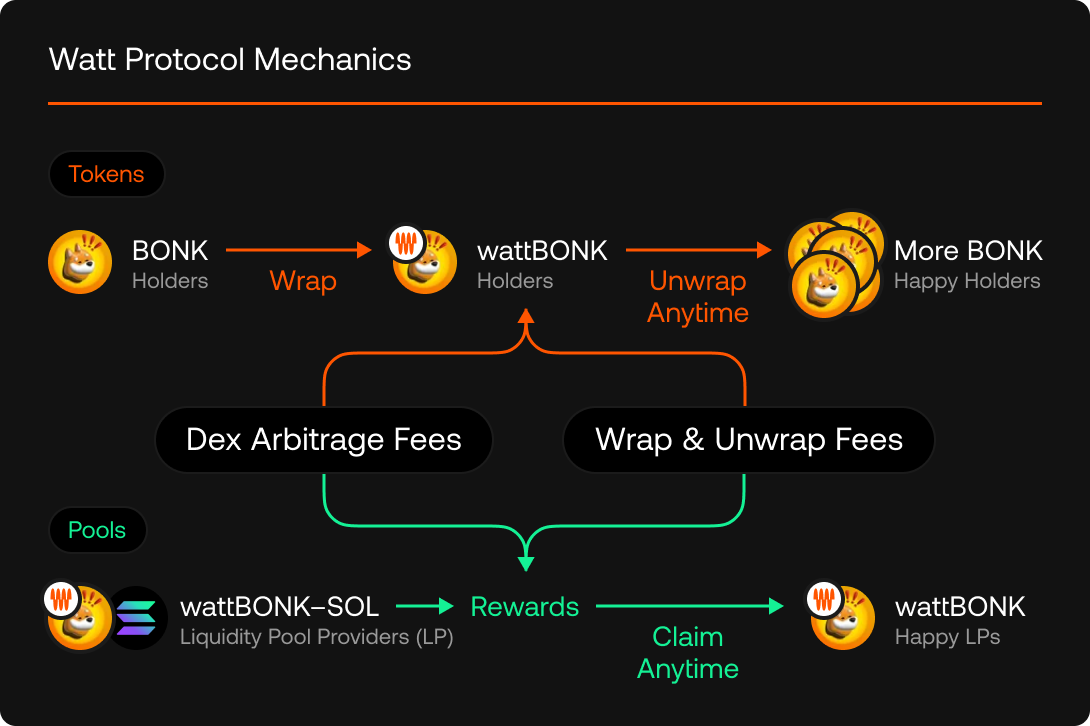
“It’s Changing the Landscape” - Watt Protocol Founder Bullish on Volatility Farming
Solana’s emerging DeFi protocols continue to push the boundaries of financial assets.
- Published:
- Edited:
DeFi is arguably the industry’s oldest sector, but that doesn’t necessarily mean that developers are running out of fresh ideas.
Watt Protocol, an emerging DeFi app, wants to help users get the most out of their idle capital by turning any SPL token into a yield-bearing asset.
To get to the bottom of this supposed infinite-money glitch, SolanaFloor sat down with Watt Protocol founder, Vlad Picha, to learn more about the ins and outs of volatility farming.
What is Volatility Farming?
Watt Protocol takes the theoretical principle of a liquid staking token and looks to apply it to every asset on the Solana blockchain. Leveraging Solana token extensions, specifically the TransferFee tool, Watt Protocol claims that it can create a volatility and arbitrage-powered flywheel that lets anyone generate yield on previously stagnant assets.
"When you wrap any SPL token in our application, you get back a LiquidStaked representative with the baked-in TransferFee. The natural question would be, where does the yield come from? There are at least two different sets of DEX pools in the market. One with the original token and another one with the LiquidStaked $wattTOKEN."
Picha went on to explain that, as arbitrageurs raced to profit from discrepancies and maintain parity between pools, the $wattTOKEN’s transfer fee is paid out as yield. In the same way that rewards are allocated to Solana LSTs, yield generated via Watt Protocol’s flywheel is distributed to the wrapped $wattTOKEN.
“Price volatility moves the price on the original trading venue. We know very well from data onchain, there are experienced traders, MEV searchers, and arbitrage bots that are scanning the network and trying to find profitable trades... If there is a price discrepancy in the original pool, the Watt pool will get balanced. Any time that happens, we take a small fee and redistribute the fee to the $wattTOKEN holders and to liquidity providers to get the flywheel spinning.”

The possibility to transform any asset on the chain into a yield-bearing asset could add a new layer of capital efficiency to Solana DeFi. If the model proves successful on mainnet, users might find greater incentives to hold certain assets like memecoins, which are typically non-yield-bearing assets with little practical value.
“Why would you want to hold native, vanilla $BONK if you can hold $wattBonk?... then I can take the $wattBONK and put it into a lending protocol as collateral. And the collateral itself is getting yield. So, it's changing the landscape.”
Watt Protocol, like any DeFi application, comes with a level of risk. When pressed on how the application mitigates said security risks, Picha assured that the platform is taking all the necessary precautions to ensure users stay as safe as possible.
“The most prominent risk is, of course, the smart contract risk… We are just now undergoing audits to make sure everything is complete and really neat when we hit production.”
The Case for Solana DeFi Culture
According to the Watt Protocol founder, Solana currently offers the industry’s most compelling and attractive onchain economy. Despite receiving offers from rival chains, Picha is adamant that Solana’s high-volume, deep-liquidity DeFi environment is the best place to experiment with novel paradigms.
“I would argue there is no other chain that has such concentrated liquidity in such a low-fee transaction environment, which is great for the product that we are developing right now… We consider Solana our home. We don't plan to move anywhere, even though some offers were on the table.”
Celebrating builder support within Solana’s developer community, the Watt Protocol founder highlighted the impact of its success in the Colosseum Hackathon. Claiming 5th position in Colosseum’s Radar Hackathon DeFi track, Picha acknowledged that the protocol’s participation in the event significantly helped it gain recognition from other teams.
“When we won the hackathon and when we were invited into the accelerator, we started to be recognized by other prominent players in the industry. I think that the highest value that Colosseum guys can provide to you is opening doors to other teams, making integrations, making connections.”
When Launch?
While the application is yet to go live on mainnet, Picha indicated that the Watt Protocol was on track to make its onchain debut in the coming months. Watt Protocol will first be deployed on DevNet, however, the founder acknowledges that DevNet testing is unlikely to give early users a fair indication of yield generation, given the environment’s limited liquidity.
“We definitely have a plan to first publish on DevNet so that people can somehow play with that, although it's kind of limited because there is not that much liquidity on DevNet… Provided the security audits go good, we plan to deploy on mainnet in six to eight weeks from now.”
Watt Protocol’s mainnet launch will serve as a key Proof-of-Concept for the application. While Picha asserted that simulations using onchain historical data indicated that the platform’s volatility farming model would offer generous yields for users, the mainnet environment will be the true test of the flywheel.
Read More on SolanaFloor
If the Trump Family isn’t behind the $TRUMP wallet, who is?
Trump Family Denies Involvement with Magic Eden-Powered $TRUMP Wallet
Level Up Your DeFi Knowledge



